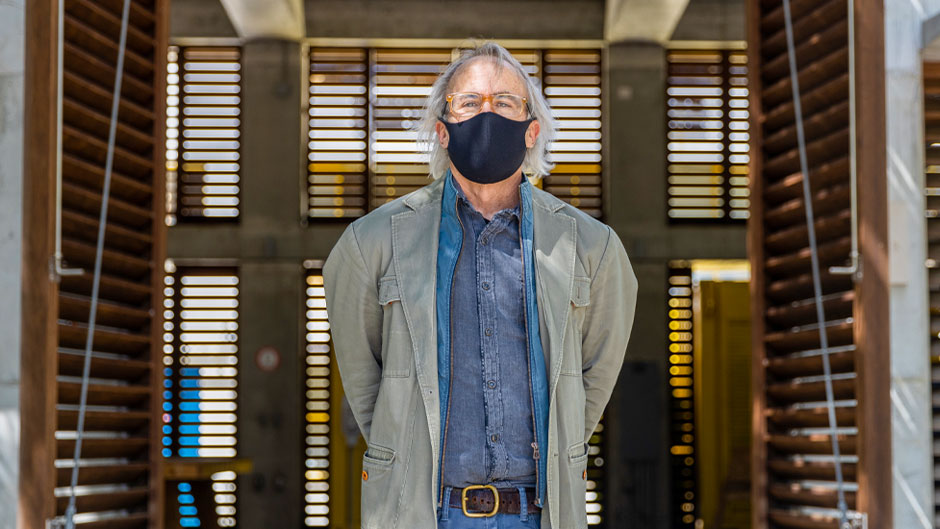Very few architects live and work surrounded by their own creations. Very few architects get their hands dirty as they work. That is not the case with Rocco Ceo.
A professor of architecture at the University of Miami School of Architecture, Ceo co-founded and co-heads the design/build program, and supervises his students as they build structures that often end up on campus.
Indeed the B.E. & W.R. Miller Build Lab, in which design and build classes are held, was designed and built by Ceo and his students. So was the Billy Goat Coffee Kiosk, a 42-square-foot cedar kiosk that allows students to serve coffee during the day and when its multi-levered panels are shuttered, becomes a lantern at night.
Ceo, who has been teaching at the University for 33 years, was raised in the town of Tequesta in Palm Beach County, Florida, and developed a love of nature and art that has lasted a lifetime. He began taking painting lessons at 8 years old and spent long hours drawing landscapes. His intention was to become an artist.
But when he arrived at the Rhode Island School of Design on a painting scholarship, he realized the program was not geared toward realist painters.
“I could not pursue an area of painting that I wanted but architecture looked like an interesting discipline,” he said. “I always thought that art and architecture were connected.”
Indeed, Ceo still devotes time to his initial love of art. He teaches classes on freehand and mechanical drawing, drawing seminars on color theory, a class on Michelangelo, and documental courses on Historic American Building Survey and Historic American Landscape Survey.
“At his core, Rocco is an accomplished artist and has an incredible facility to visualize and draw,” said James Adamson, lecturer, who has been co-teaching with Ceo in design/build since 2009. “This serves him well as both an architect and a teacher. It is also important to have passion in whatever you do. Rocco has it. We are lucky to have him.”
It is that love of design that Ceo, along with Adamson, bring to the design/build lab. They also instill in students a passion for getting to know the materials they work with.
“One thing is to sit at your desk and draw and design something and another is to have a feel for how it all goes together, how materials behave,” he said. “I think design/build gives students a chance to work with their hands in a way that they have never worked before.”
Since the program began, design/build classes have tackled about 11 projects, most of them completed in 16 weeks from start to finish. Each prototype is created for a nonprofit community organization.
Three projects were among the most challenging:
- An eco-tent was created for Flamingo Park in the Everglades. Working with the South Florida National Parks Trust and Everglades National Park, the students built an environmentally friendly tent prototype that could withstand the elements and could be easily taken down during hurricane season.
- A mobile Permakitchen was built for Earth Learning, a nonprofit group in Miami, that teaches food preparation to marginalized communities. The students encountered the challenges of repurposing a mobile home and adapting it to a completely different use. The group had to salvage the original structure, down to its chassis, and weld a new frame to accommodate a demonstration kitchen that operated with solar power.
- A chicken coop was constructed for Empower Farms, a Redlands-based farm that employs individuals with disabilities to undertake various agricultural activities. The coop, which accommodated up to 30 chickens, was fashioned to keep the animals safe from predators. Using western red cedar and sporting a steep gabled roof (for more ventilation), the coop has bays so the chickens can nest their eggs and sturdy doors to keep them safe at night.
“The coop is built on a trailer chassis so it could be moved anywhere on the organic farm, allowing the chickens to keep the insect population in check,” Ceo said. “The coop has been very successful; the chickens are safe and egg production is way up.”
Besides his classroom work, Ceo has devoted his time to published work which has resulted in award-winning books. “Redland: A Preservation and Tourism Plan,” done with Margot Ammidown and Maria Nardi, was the result of a two-year project, along with the Dade County Historic Preservation Office, to look at the effects of Hurricane Andrew on the often-neglected Redland area. Ceo led the project along with other county officials and students. The book provided a plan on the issues affecting the area and recommendations for the future zoning and building of the devastated area.
He also wrote “Historic Landscapes of Florida,” co-authored with Professor Joanna Lombard. The book, funded by the Deering Foundation, was the culmination of 10 years of the professors working with students to document Florida gardens and landscapes.
More recently, with the support of the James Deering Danielson Foundation, Ceo was able to research the origins of the Miami-Dade Parks system, working with University of Miami architecture students to develop a series of drawings of the early parks. He and Lombard collaborated in related research resulting in the book, “Building Eden, The Beginnings of Miami-Dade County’s Visionary Park System.”
“Essentially, wherever Rocco is working, his contributions can be expected to be outstanding,” said Lombard. “He is a notable exemplar of an architect who works across boundaries, engaging across communities, teaching and innovating across disciplines, focusing all of his energy and commitment on helping others to advance.”
For his “exceptional work and contributions to architecture and society,” Ceo was recently selected as one of the American Institute of Architects 2021 Fellows. The AIA College of Fellows is the highest membership honor the organization grants.
“This is one the highest honors bestowed by the AIA,” said Rodolphe el-Khoury, dean of the School of Architecture. “The elevation of a faculty member to this status puts the entire school in a favorable light.”

